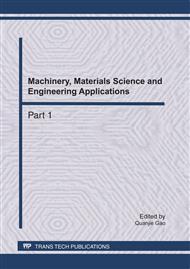p.490
p.496
p.500
p.505
p.509
p.514
p.519
p.526
p.532
Study on the Electrical Arc Ablation Performance of Nano-SiCW Reinforced Cu-Matrix Composites
Abstract:
The nano-SiC whisker reinforced Cu-matrix composites (SiCw/Cu) were obtained by powder metallurgy processes. The electrical arc ablation performance of composite SiCw/Cu was compared with copper H62 through stagnation-point ablation experiments. The results indicated that the qualities of copper H62 samples decreased with the increasing of ablating current; and the qualities of SiCw/Cu samples firstly increased and then decreased with the increasing of ablating current. Ablation mechanism research indicates the ablation hole of SiCw/Cu is smaller than copper H62, but it produced micro cracks because of different thermal expansion coefficients between nano-SiC whisker and Cu-matrix. At the same time, nano-SiC whisker happens to intricate oxidation reaction during arc ablation, it can reduce Cu-matrix smelts and sprays by absorbing arc energy. The anchoring effect and protection for the copper matrix of the uniformly dispersing nano-SiC whiskers have been considered to contribute the excellent arc ablation performance of composite SiCw/Cu.
Info:
Periodical:
Pages:
509-513
Citation:
Online since:
April 2011
Authors:
Keywords:
Price:
Сopyright:
© 2011 Trans Tech Publications Ltd. All Rights Reserved
Share:
Citation:


